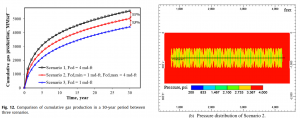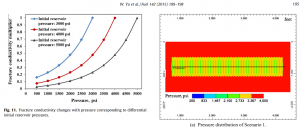Numerical study of the effect of uneven proppant distribution between multiple fractures on shale gas well performance
Abstract
Uniform proppant distribution in multiple perforation clusters after hydraulic fracturing plays an important role in the commercial production of shale gas. However, it is very challenging to achieve a uniform proppant distribution during operation. In some cases, proppant distribution is uneven in different clusters within the same hydraulic fracturing stage. The effect of the uneven proppant distribution on well performance is not well understood and has been largely neglected in most reservoir simulations.Hence, it is paramount to develop a reservoir simulation approach to properly examine the relationship between proppant distribution and well performance for shale gas reservoirs.
In this paper, we use numerical reservoir simulation to model the proppant distribution. The reservoir model with multiple hydraulic fractures is validated by fifield production data from Marcellus shale. Effects of gas desorption and stress-dependent fracture conductivity are considered in the simulation model. We perform sensitivity studies to quantify the key parameters affecting the well performance between uniform and nonuniform proppant distribution.
The six variables, which are cluster spacing, initial reservoir pressure, fracture conductivity, fracture half-length, fracture height, and matrix permeability, are investigated. The fracture conductivity ratio of 1:1.5:2.5:4 for four clusters in the same fracturing stage is investigated for the uneven proppant distribution scenario. This work provides insights into a better understanding of the effect of proppant distribution on well performance.



